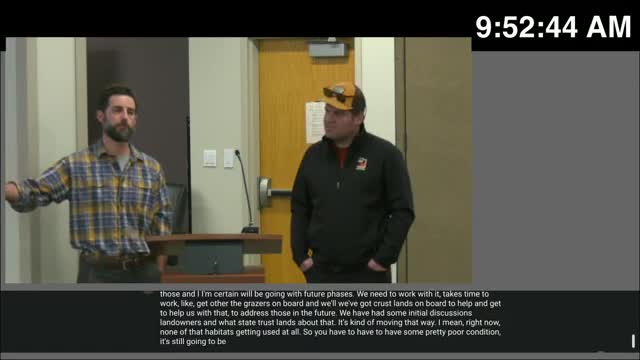Habitat restoration project planned for local fish spawning streams
March 22, 2025 | Natural Resources Department, Utah Environment, State Agencies, Organizations, Utah Executive Branch, Utah
This article was created by AI summarizing key points discussed. AI makes mistakes, so for full details and context, please refer to the video of the full meeting. Please report any errors so we can fix them. Report an error »

The recent joint meeting of the Blue Ribbon and Habitat Council, held by the Utah Department of Natural Resources, focused on critical discussions surrounding the restoration of fish habitats in local watersheds. A significant highlight was the long-term plan for sub-watershed restoration, which aims to enhance spawning habitats for fish, particularly in the context of stream restoration efforts.
The meeting revealed that the restoration process will unfold over several years, with an emphasis on improving water flows and creating a more conducive environment for fish spawning. Experts discussed the timing of fish migrations, noting that adult fish typically begin their journey upstream from mid-April through June, with some even extending into July. This timeline is crucial for local anglers and conservationists, as it indicates when fish populations will be most active in the area.
Additionally, the discussions touched on the lifecycle of the fish, including how long the fry, or young fish, remain in the streams before returning to the lake. It was noted that these young fish could spend anywhere from a few months to a couple of years in the streams, depending on various environmental factors.
The implications of these restoration efforts are significant for the local community. Improved fish habitats not only support biodiversity but also enhance recreational opportunities for fishing enthusiasts. As the restoration progresses, residents can look forward to healthier ecosystems and potentially increased fish populations in local lakes.
In summary, the meeting underscored a commitment to long-term ecological restoration that promises to benefit both the environment and the community. As these initiatives move forward, they align with broader goals of sustainability and conservation in Utah's natural resources.
The meeting revealed that the restoration process will unfold over several years, with an emphasis on improving water flows and creating a more conducive environment for fish spawning. Experts discussed the timing of fish migrations, noting that adult fish typically begin their journey upstream from mid-April through June, with some even extending into July. This timeline is crucial for local anglers and conservationists, as it indicates when fish populations will be most active in the area.
Additionally, the discussions touched on the lifecycle of the fish, including how long the fry, or young fish, remain in the streams before returning to the lake. It was noted that these young fish could spend anywhere from a few months to a couple of years in the streams, depending on various environmental factors.
The implications of these restoration efforts are significant for the local community. Improved fish habitats not only support biodiversity but also enhance recreational opportunities for fishing enthusiasts. As the restoration progresses, residents can look forward to healthier ecosystems and potentially increased fish populations in local lakes.
In summary, the meeting underscored a commitment to long-term ecological restoration that promises to benefit both the environment and the community. As these initiatives move forward, they align with broader goals of sustainability and conservation in Utah's natural resources.
View full meeting
This article is based on a recent meeting—watch the full video and explore the complete transcript for deeper insights into the discussion.
View full meeting

